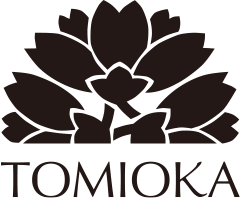
Kaba-zaiku Overseas expansion in collaboration with overseas designers
Tomioka Shoten in Semboku City, which manufactures and sells Kaba-zaiku, a traditional craft that represents Akita, is actively developing products with overseas designers and exhibiting at international trade fairs in order to widely disseminate the appeal of Kaba-zaiku. We interviewed President Mr. Koki Tomioka about the background of overseas expansion and the outlook of management. (Interviewer: Tomonori Shimizu)
What was the impetus for overseas expansion?
The Lehman shock in 2008 and the Great East Japan Earthquake in 2011 were two key factors. High-priced items such as tables and lighting fixtures were not selling due to the Lehman shock, and products delivered to the Sanriku region were damaged by the Great Earthquake, and sales continued to slow down thereafter. In 2012, we exhibited for the first time at an international trade fair in Germany, focusing on about 30 products that incorporated modern designs, and we were able to conclude business negotiations with famous French brands. There is no other product made with beautiful wild cherry tree bark like Kaba-zaiku overseas, and it is unique in the world. Cherry blossoms also overlap with the image of Japan.
The reason for collaborating often with overseas designers:
The key word needed for overseas expansion is "localization." If you want to sell in France, you need to get to know local creators and keep thinking about what kind of products will be popular. The interior panels of Kaba-zaiku, the latest work released last month, are a result of this experiment. This product was created in collaboration with a designer from South America living in France, and as an interior decoration designed in a modern way using traditional craft materials. It is a product that can be used in various situations such as hotels and public facilities. Wild cherry tree bark is a sustainable material and is well received overseas.
What are the future management issues?
The problem is the procurement of wild cherry tree bark, which is the raw material. Kaba-zaiku was a "Samurai Job" in the Edo period, but it has since been elevated to the level of art. The materials which can be used for art are limited to the portions which are reddish-purple, shiny, and strong. Not all of the wild cherry tree bark collected could be used, which made it difficult to develop new products.
On the other hand, the wild cherry tree grows in broad-leaved forests, so going into the mountains to collect it is hard work. For some reason, trees which are more suitable for Kaba-zaiku grow in more harsh environments with poor soil and limited sunlight. Moreover, the collection time is limited to a short period from the end of the rainy season to the beginning of September, when the bark is rising from the trunk.
Every year they venture into the mountains themselves, but sometimes it takes two hours to get to the collection site and back. In order to secure income for the people who collect it, it is necessary to develop new products that can make use of wild cherry tree bark, which is not suitable for tea canisters. Kaba-zaiku's interior panels are a promising product in this sense as well. We believe that the “richness that comes from the continued use” of Kaba-zaiku, a traditional craft unique to Akita Prefecture, is the only one in the world that contributes to enriching people's lives. That is our company's management philosophy. In the future, we would like to continue to transmit the value that transcends time and space in Kaba-zaiku.
Koki Tomioka
Born in Daisen City. After graduating from Kakunodate High School and a university in Tokyo, he joined Tomioka Shoten in 1985 and became president in 2005. He is the executive director of the Kakunodate Crafts Cooperative and a director of the Semboku City Chamber of Commerce and Industry. He started aikido in high school and has a 6th dan degree and is a board member of the Japan Aikido Association.

